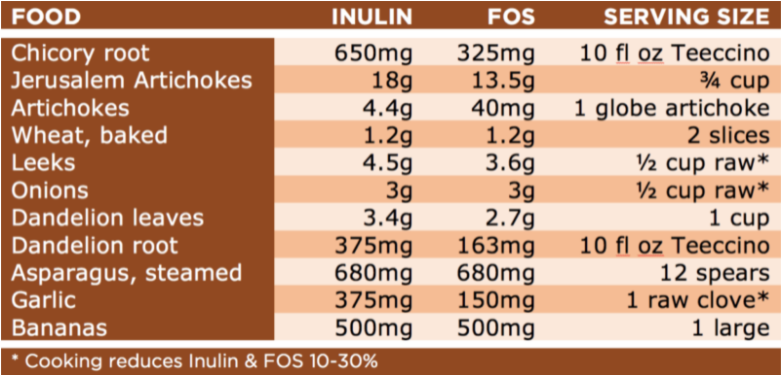I’m on a crusade to educate everyone about good gut health. Now more than ever before, we have the tools to support optimal digestion yet we have more digestive problems than ever. It seems like everyone has issues with allergies, leaky guts, bowel disorders, auto-immune diseases, acid reflux or just plain old gas and bloating. If this describes anything you’re experiencing, this post is written for you!

What is the microbiome?
Just in case you’re not familiar with the term “microbiome”, it is the community of all the “microbiota” (the microbes including bacteria and fungus) that live in your intestinal tract starting in your mouth right down through your colon. It also includes the microbes that live in your nose and lungs, on your skin, and in your reproductive areas.
It turns out that we have over 1,000 species of microbiota just in our intestines alone that contain trillions of genes co-inhabiting our bodies. What’s more, without them, we actually cannot live. Seriously, without a functioning microbiome, we die quickly. In comparison, we only have 22 thousand human genes, which means our mammalian genes are only around 1% of all the genes in our bodies. So, let’s talk about who’s in charge here!
From 2008 – 2013, the Human Microbiome Project sequenced our microbiota and now science is fascinated by how even small populations of microbe species can change how much you weigh, influence how many vitamins are produced in your colon, affect how your immune system is functioning, keep pathogens at bay and even determine what chronic health conditions you will develop as you age. Everything from allergies to food sensitivities, diabetes to heart disease, and obesity to cancer are influenced by the health of our microbiome.
Lest this sound overwhelming, the answer to supporting a healthy microbiome is as close as a cup of Teeccino (which we hope you’re drinking while you read this!)

Seeding the microbiome at birth
It all starts when we’re born. As the baby moves through the mother’s vaginal canal, he/she receives the mother’s microbiota. Next,the nursing baby consumes mother’s milk full of oligosaccharides, which are non-digestible carbohydrates that feed and support the development of the microbiome.
Cesarean section baby? Bottle fed? Sorry but the microbiome is starting out seriously deficient and the lack of essential microbiota can change how the baby’s organs and immune system are going to develop. It’s truly that serious.
For me, it was a personal revelation because one of my sons was born cesarean section and the other was born vaginally. Both were breast fed but it turns out that even mother’s milk from cesarean section births contains fewer probiotics than the mother’s milk from vaginal births.
My cesarean section son had skin rashes, colds every month for the first year of life, and digestive disorders from the start. My vaginally born son? Totally healthy.
Your community of microflora
Think of what we know about ecology and how natural environments break down when one or more species are removed. They may not even be the most populous or dominant species, but they still play an essential role to the functioning of the whole.
That’s the way our microbiome functions. Each microorganism and all its many strains are essential. They depend on other microbiota to survive and inhabit the right place at the right time for the whole microbiome to thrive. It’s all about balance and you can’t be balanced if essential species are missing or underdeveloped.
So, if we’re born vaginally and are breast fed, is our microbiome OK? That depends on what drugs we may be given. Antibiotics are known to kill off various types of microbiota. What about other prescription drugs? Future studies will address how drugs, environmental toxins, GMOs and agricultural chemicals on our food all affect our microbiome.

Microbiome and weight management
I know, it sounds like science fiction but here’s the truth ~ our microbiome can affect what we want to eat and thus how much weight we gain. Studies show that certain phylum of bacteria called Firmicutes are more prevalent in obese people whereas another phylum of bacteria, the Bacteriodes dominate in people of normal weight. It turns out that our microbiota can even influence what kinds of foods we crave as they actually have preferences for different types of carbohydrates.
The ratio of Bacteriodes to Firmicutes in our gut is still being studied, but guess what? Most of us are Firmicutes dominant.
All the probiotics on the supplement market are members of the Firmicutes clan. Since Bacteriodes are anaerobic bacteria, no probiotic company has been able to develop them for supplementation. Instead, they’ve been providing and researching strains of Firmicutes bacteria that are good for our health, but they don’t help restore the ratio of Bacteriodes that are associated with optimal weight.
There’s only one way to support your Bacteriodes in your gut... More on that in a bit!

Anxiety and our guts
Anxiety anyone? 90% of our serotonin and at least 50% of our dopamine, the feel-good neurotransmitters that lessen anxiety and promote feelings of well-being, are produced in our guts. It turns out that our microbiota play an essential role in producing both of them. Studies show that when our microbiota dysfunction is remedied, anxiety is reduced and people start to feel good. There are even ongoing studies about the microbiome and autism because it turns out that scientists can produce autistic behavior in mice when they diminish one of the short chain fatty acids produced by gut microbiota.
Nourishing your microbiome
While this all may sound scary and foreboding, I want to give you the good news that will make your microbiome very happy. If you supply them with the right nutrients, your microbiome will sort itself out and thrive!
Except for in extreme cases, most of us still have a varied population of gut microbes, However, some species may not be as populous as they should be and also, they may not be populating the right niche in your gut. They may not be in a balanced relationship to the rest of your microbiome’s species in order to function optimally. Beneficial bacteria can become pathogens when they grow where they shouldn’t.
Furthermore, if they don’t have enough to eat, they may eat you! Yes, it’s true. They will burrow in and eat the mucus lining of your gut in order to survive. Guess what that leads to? Leaky gut syndrome, the source of many food allergies and other inflammatory intestinal conditions like IBS and Crohn’s Disease.
Prebiotics to the rescue
So, what do they eat? Prebiotics, not probiotics. Prebiotics are soluble fibers and other non-caloric compounds that are not digested in your stomach or small intestines and thus don’t contribute calories to your diet. Instead, they arrive in the colon ready for your microflora to get busy fermenting.
The byproducts of fermented prebiotics are Short Chain Fatty Acids (SCFAs) which are the energy source for the human cells in your colon. They are necessary for your immune system to function fully, to decrease inflammation, and to prevent obesity by influencing the appetite and improving insulin sensitivity.

Inulin and fructo-oligosaccharides
If you drink Teeccino and read our package copy, you’ve seen that Teeccino contains inulin that naturally extracts during brewing from chicory root. Inulin is a prebiotic soluble fiber that feeds beneficial intestinal microbiota. It’s found in many foods but in small quantities.
In past newsletters I’ve talked about how we humans used to eat 15 grams of inulin daily in our hunting and gathering days. Now we’re lucky to get 2-3g of inulin daily from the American diet. For those of us cutting out whole wheat, it turns out that a study of the American diet showed that wheat provides 70% of our inulin. All of a sudden, you might be starving your microflora if you’ve gone grain free or Paleo!
Here are the foods you need to eat in order to get enough inulin and FOS, fructo-oligosaccharides, another non-digestible soluble fiber that’s a favorite food of your microflora. Inulin and FOS typically occur together in foods. Remember though: you have to feed your microflora daily and in large quantities in order to get your daily dose of 15 grams!

Other sources of prebiotics
Beyond Inulin and FOS, there are other soluble fibers and oligosaccharides that are also prebiotics. Some people are sensitive to inulin and FOS when supplemented in higher dosages than normally found in food. Their fructose component may produce gas and contribute to intestinal discomfort for those sensitive people. However, other types of oligosaccharides that aren’t high in fructose don’t produce these effects and can be safely eaten to produce good results.
Not all soluble fibers are prebiotics by the way. Some just add to the softness of our stools and they add mucilage that helps the stool move easily through our colon.
Science is identifying new prebiotics that were known to have beneficial effects on human health but their relationship to the microbiome hadn’t yet been discovered. For instance, a soluble fiber from oats and barley called beta-glucan is recognized by the FDA as reducing the risk of heart disease by lowering cholesterol when consumed in a diet that is low in saturated fat. Scientific studies are now indicating that these effects may be due to the microbiota that consume the beta-glucan.
Here’s the amount of you would need to eat on a daily basis to get these prebiotic benefits:

Fermented foods such as miso, soy sauce, sauerkraut, Kimchi and other fermented vegetables contain Isomalto-oligosaccharides (IMO), another type of oligosaccharide prebiotic. It’s undetermined how much you would need to consume daily of fermented foods, but it is believed that the quantity is much higher than just a typical single serving would provide.
Polyphenols, the antioxidants in our fruits, vegetables and herbs, are also being shown to have prebiotic effects. I’ve always been a huge advocate of eating as many plants as possible to get a diversity of polyphenols. Herbs and spices are a major source of unique polyphenols that you won’t otherwise find in the fruits and vegetables we normally consume.
Though the science is still young, it is looking like hard-to-digest polyphenols, like curcumin from turmeric for example, may actually be fermented in our colons by our microbiota. No one knows yet what species of microbes prefer which polyphenols, but suffice it to say, consuming as many of these important antioxidants as possible will improve our health and the diversity of our microbiome!

Supplementing with prebiotics
It probably is not possible to eat all of the above foods in sufficient quantities daily in the course of our busy lives. Fortunately, there is a lot of good evidence that nourishing our beneficial microbiota with concentrated prebiotics produces great results.
It was studies on the effect of oligosaccharides on our microbiome that convinced me that I should develop some blends of Teeccino that have a greater prebiotic impact than just inulin alone. I was impressed by the studies on XOS, xylo-oligosaccharide, and GOS, gluco-oligosaccharide, so I tried them out on myself.
I’m pretty healthy so it can be hard for me to notice an effect from a nutritional supplement if I don’t have any symptoms that would be relieved by taking it. However, XOS and GOS had a noticeable impact on my digestion and elimination. It’s like everything got more efficient and better at processing what I ate. I actually noticed a number of things that changed for the better!
As microbiome dysfunction is relieved, all sorts of great effects come about depending on what your microbiome deficiencies were. You’re just going to have to try it for yourself to find out how prebiotics affect you!
I always say that our bodies are our best laboratories. So, here’s what I recommend. Drink Teeccino Prebiotic SuperBoost blends daily for a month or two and start to notice the difference they make. Then please share them with the rest of us!



2 comments
In the article it mentions that teeccino “influences your appetite” what does this mean? Thank you!
———
Teeccino:
The soluble fibers and other non-caloric compounds that are not digested in your stomach may decrease you appetite by giving you a full feeling
Hi Caroline,
Do you know if FOS/GOS/XOS are good for Crohn’s Disease? I keep finding contradictory information online and it’s so confusing.
I have been drinking Teeccino for many years now and I love it. I don’t want to give it up but I’m trying to heal my Gut and so far, it’s not happening.
Any advice or site information you can share on FOS/GOS/XOS?
Thank you,
Maria